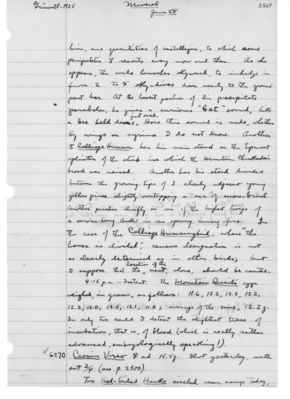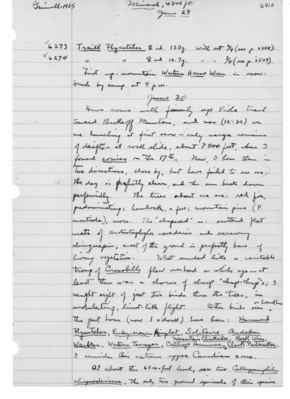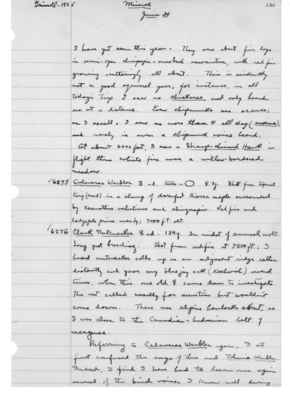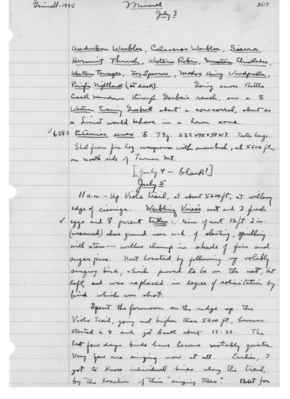Pages That Mention snow bush
1925: Joseph Grinnell's field notes
S2 Page 48
Collector: Grinnell - 1925 Location: Mineral Date: June 28 Page Number: 2502
her wings. As the [sic] left, in a hurry, the positions of some of the eggs changed; one egg was thrown up the side of the nest a bit. Set taken, 1/9 [See p. 2507]. As previously stated (p. 2481) the nest is on a log, this being old and rotten, flattish on top, even lengthwise hollow or depressed at the point where the nest is. In this longitudinal groove (as it were) is an accumulation of bits of rotten wood, old cone scales, and brown dry last-year's ceanothus leaves. The "nest" is a saucer-shaped depression in this mixture of debris, about 150 mm. across (measured) by 35 mm. deep. About a dozen feathers of the quail enter into the "lining." The whole site is well concealed and protected by the flattened, thorny branches and dead twiggery of the snow-brush which sprawls over the log from the south side. A heavy clump of young firs grows 25 feet to the south and west and serves to shade the place most of the afternoon
Ruby-crowned Kinglet's nest: rim 5180 mm. above ground; in young white fir, 10 inches in diameter 3 ft. from ground; nesting, with practically no attachment on flat mass of fir bough - stem, ^live twigs and needles beneath. Bough, from bole of tree, slightly drooping, towards southwest - sunny exposure. Nest out on bough 960 mm. from bole, in from extreme end of bough 880 mm. Could be seen from ground only
S2 Page 53
Collector: Grinnell - 1925 Location: Mineral Date: June 28 Page Number: 2507
him, are quantities of castillejas, to which some peripatetic [female symbol] resorts every now and then. As she appears, the male launches skyward, to indulge in from 2 to 5 sky-dives down nearly to the ground past her. At the lowest portion of this precipitate parabola, he gives a curious "bzt" sound, like a bee held down, ^just once. How the sound is made, whether by wings or syrinx I do not know. Another [male symbol] Calliope Hummer has his main stand on the tipmost splinter of the stub in which the Mountain Chickadee's brood was raised. Another has his stand divided between the growing tips of 3 closely adjacent young yellow pines slightly overtopping a sea of snow-brush. Another perches chiefly on one of the highest twigs of a service-berry thicket in an opening among firs. In the case of the Calliope Hummingbird, where "the house is divided," census designation is not as clearly determined as in other birds; but I suppose that the ^location of the nest, alone, should be counted.
4:15 p.m. - Intent. The Mountain Quail's eggs weighed, in grams, as follows: 11.6, 12.2, 12.3, 13.2, 12.2, 12.0, 12.5, 12.1, 11.4; average of the nine, 12.2 g. In only two could I detect the slightest trace of incubation, that is, of blood (which is really rather advanced, embryonically speaking!).
6270 Cassin Vireo [female symbol] ad. 15.5 g. Shot yesterday, with set 2/4 (see p. 2500).
Two Red-Tailed Hawks circled near camp today,
S2 Page 57
Collector: Grinnell - 1925 Location: Mineral, 4800 ft. Date: June 29 Page Number: 2510
6273 Traill Flycatcher [female symbol] ad. 13.0 g. with set 3/4 (see p. 2508). 6274 Traill] [Flycatcher] [female symbol] ad. 12.7 g. [with] [set] 3/4 (see p. 2509).
First up - mountain Western House Wren in snow brush by camp at 4 p.m.
June 30 Have come with family up Viola trail towards Brokeoff Mountain, and now (12:30) we are lunching at first snow - only meagre remains of drifts - at rock slide, about 7500 feet, where I found conies on the 17th. Now, I hear them in two directions, close by, but have failed to see one. The day is perfectly clear, and the sun beats down perfervidly. The trees about me are: red fir, predominating; hemlock, a few; mountain pine (P. monticola), more. The "chaparral" is: scattered flat mats of arctostaphylos nevadensis and scrawny chinquapin; most of the ground is perfectly bare of living vegetation. What sounded like a veritable troup of Crossbills flew overhead a while ago - at least there was a chorus of sharp "chup-chup's"; I caught sight of just two birds thru the trees, in undulating, linnet-like flight. Other birds seen ^or heard here the past hour (now 1 o'clock) have been: Hammond Flycatcher, Ruby-crown Kinglet, Solitaire, Audubon Warbler, Western Tanager, Calliope Hummer,^ Mountain Chickadee, Rock Wren, Clark Nutcracker. I consider this extreme upper Canadian zone.
At about 6500-foot level, saw two Callospermophilus chrysodeirus, the only two ground squirrels of this species
S2 Page 58
Collector: Grinnell - 1925 Location: Mineral Date: June 30 Page Number: 2511
I have yet seen this year. They were about fir logs in semi-open chinquapin-snowbush association, with red fir growing scatteringly all about. This is evidently not a good squirrel year; for instance, in all today's trip I saw no chickaree, and only heard one at a distance. Even chipmunks are scarce; as I recall, I saw no more than 4 all day (amoenus), and rarely is even a chipmunk voice heard.
At about 6000 feet, I saw a Sharp-shinned Hawk in flight thru the white firs near a willow-bordered meadow.
6275 Calaveras Warbler [male symbol] ad. testes - [testes illustration] 8.3 g, Shot from topmost twig (dead) in a clump of dwarfed Sierra maple surrounded by ceanothus velutinus and chinquapin. Red firs and lodgepole pine nearby; 7000 ft. alt.
6276 Clark Nutcracker [female symbol] ad. 134 g. In midst of annual molt. Long past breeding. Shot from red fir at 7500 ft.: I heard nutcracker calls up on an adjacent ridge rather distantly and gave my bluejay call (Kochwish) several times, when this one old [female symbol] came down to investigate. The rest called nasally for sometime but wouldn't come down. There were alpine hemlocks about, so I was close to the Canadian-hudsonian belt of mergence.
Referring to the Calaveras Warbler again, I at first confused the songs of this and Tolmie Warbler. Indeed, I find I have had to learn over again several of the bird voices I knew well during
S2 Page 66
Collector: Grinnell - 1925 Location: Mineral Date: July 3 Page Number: 2519
Audubon Warbler, Calaveras Warbler, Sierra Hermit Thrush, Western Robin, Mountain Chickadee, Western Tanager, Fox Sparrow, Modoc Hairy Woodpecker, Pacific Nighthawk (at dusk). Going across Battle Creek Meadows through Gerber's (?) ranch, saw a [male symbol] Western Evening Grosbeak about a cow-corral, about as a Linnet would behave in a lower zone.
6283 Eutamias senex [male symbol] 79g. 232x98x34x17. Testes large. Shot from fir log overgrown with snowbush, at 5500 ft., on north side of Turner Mt.
July 4 - blank!]
July 5 11 a.m. - Up Viola trail, at about 5600 ft., at willowy edge of cienaga. Warbling Vireo's nest and 3 fresh eggs and female parent taken: rim of nest 12 ft. 2 in. (measured) above ground near end of slanting, spindling will [sic] stem - willow clump in shade of firs and sugar pine. Nest located by following up volubly singing bird, which proved to be on the nest, but left, and was replaced in degree of solicitation by bird which was shot.
Spent the forenoon on the ridge up the Viola Trail, going not higher than 5600 ft., however. Started a [sic] 8 and got back about 12:30. The last few days birds have become notably quieter. Very few are singing now at all. Earlier, I got to know individual birds along the trail, by the location of their "singing trees." But for




